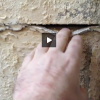Did my downspouts cause my basement to leak?
Considering most basements are anywhere from four to eight feet underground, we have to considerthe conditions that are responsible for water intrusion. For example, what type of soil surrounds the home, how old is the structure, or perhaps how was the home constructed.
Most homes in the greater Washington D.C. area, for example, constructed in the last 70-80 years are fundamentally built the same way, that is, with a poured concrete footer supporting either a block or concrete wall. This cold joint (seam) between the footer and the wall, or the floor and the wall, is a primary weak spot in basements that experience water intrusion problems (no matter where the water comes from).
Clays of all types are found in this area of the country. Whether marine, plastic or sandy, clay was deposited along the greater Mid Atlantic area by ancient oceans and fresh water rivers. One characteristic of clay that most people are familiar with is its resistance to water infiltration. (Clay pots, for example)
The water table established in any neighborhood during a rain event is influenced primarily by the inches of rain falling and the number of square miles being rained upon. Rain becomes ground water and flows under the surface, past all the homes in a given area pretty much the same way, at the same depth. While a “false” water table is established during a prolonged rain event, it will eventually subside to normal levels during dryer periods.
The key here is that surface water running off of a single home will not penetrate the under-surface clay soil to the point of influencing the enhanced water table at any particular house. In other words, when it rains, it rains for many miles around the home with the leaky basement. Under-the-surface water, sometimes from many hundreds of feet away, and the great pressure of its own weight (water is pretty heavy), will find its way into a basement with a compromised seam between the footer and the wall. No amount of surface water drainage enhancement or landscaping change will influence water 8 feet below the surface of a single home enough to prevent seepage thru a modern foundation (treated or untreated). If, however, your gutters are pouring water over the top of your foundation wall that is a different story entirely. The gutter pipes discharge should not be above the foundation wall anywhere.

